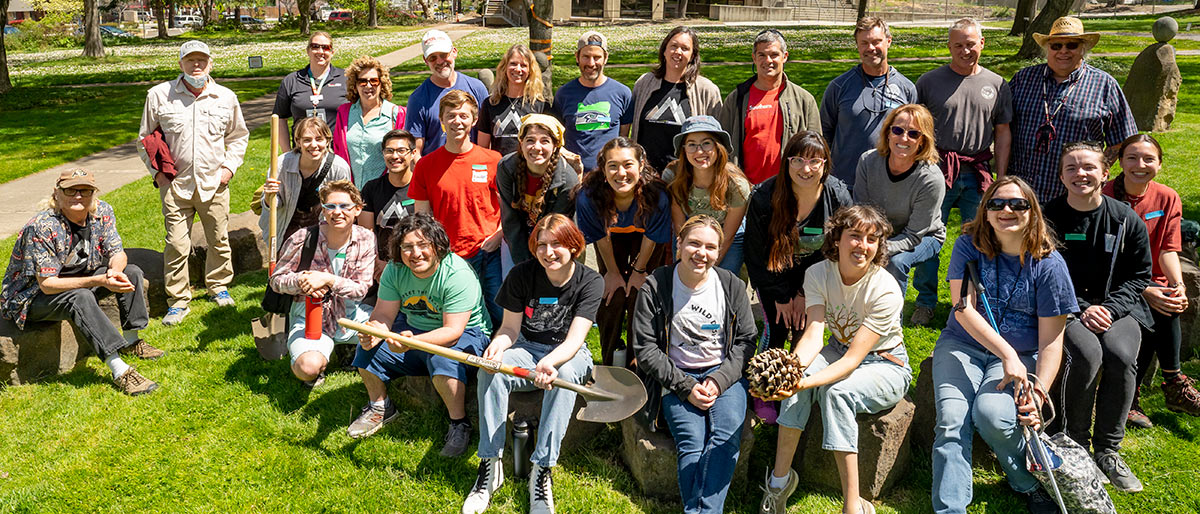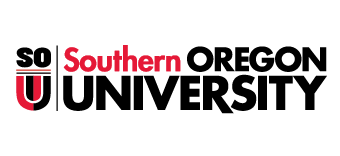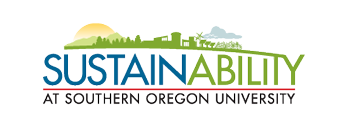SOU Climate Action

Our Climate Action Story So Far
Southern Oregon University became a charter signatory of the American College and University Presidents’ Climate Commitment (now called Carbon Commitment) in 2007 and published its first Climate Action Plan in 2010.
Sustainability is at the heart of SOU’s vision, mission, values and strategic plan, demonstrating commitment at the highest level of governance. SOU has a dedicated Sustainability Office overseeing climate action across campus. A Sustainability Council with representation from staff, students and faculty has been established since 2007 to advise on sustainability and climate action.
SOU achieved a “Gold” STARS rating in June 2025 for campus wide sustainability, as measured by an evaluation system developed by the Association for the Advancement of Sustainability in Higher Education (AASHE).
Climate action notable accomplishments for SOU’s scope 1 and 2 emissions include:
- SOU is committed to all new buildings and major renovations to meet a minimum of LEED Silver standards. The impact of this is that the buildings will use energy more efficiently and therefore reduce greenhouse gas emissions. This has included the following building projects:
- Raider Village (Housing and Dining Hall) 2014 LEED Gold
- Higher Education Center 2008 LEED Platinum Certificate
- Lithia Pavilion/Student Recreation Center 2018 LEED Gold Certificate
- SOU upgraded the mechanical equipment at the Central Plant Building on campus in 2019. Boilers 1 and 2 were replaced with high-efficiency Hurst boilers with high-efficiency Riello Burners. Boilers 3 and 4 had the burners replaced with the same high-efficiency Riello Burners. A new Riello control system was installed to operate the boilers more efficiently. A new water softener system was installed to help reduce chemical usage. The existing 800-ton and 500-ton centrifugal chillers were replaced with two 800-ton, higher-efficiency centrifugal chillers. The roof-mounted, three-cell cooling tower was replaced with a larger-capacity, high-efficiency, two-cell cooling tower. One of the two existing condenser water pumps was replaced with a larger-capacity pump.
- The operation of the HVAC system for each campus building on the University’s direct digital control (DDC) system is scheduled based on the building occupancy information. When a building is not occupied, the temperature controls go into “unoccupied” status, with a lower setback temperature during the heating season and a higher setback temperature during the cooling season. HVAC systems also upgraded during renovation projects across campus.
- LED lighting became the SOU campus standard in 2016 and all new construction and renovation projects since 2016 have incorporated LED lighting. Projects with lighting retrofits throughout the building include the Theater Building, The Lithia Motors/SRC, Britt Hall and the Recycling Center. Other renovation projects with partial LED retrofits include the Music Building, Taylor Hall, the Science Building, the Osher Lifelong Learning Institute and Raider Stadium. SOU has been gradually replacing exterior campus lighting with LED fixtures and more than half of the campus has been retrofitted with LED since 2016.
- Nine solar arrays have been installed on SOU’s Ashland campus with a total output of 455 kilowatts, plus an array at the Higher Education Center in Medford and a pole-mounted array installed last year by a nonprofit on land leased from SOU. The university’s first solar array was installed on the Hannon Library in 2000. Solar to date has been funded through private investors, grants, construction bonds, power purchase agreements with the student body and the University Administration. SOU also has three net-zero buildings on campus.
- SOU purchases electricity from the City of Ashland, which supplies low-carbon electricity (primarily hydropower) contracted through Bonneville Power Administration.
- SOU’s campus fleet follows the Sustainability and Equity in Purchasing Policy which states that preference shall be given to electrical powered motorized vehicles and tools. Where vehicles and tools are not electrical, preference will be given to less-polluting alternatives to gas and diesel, such as compressed natural gas, bio-based fuels, hybrids, electric batteries, and fuel cells, as available. Eighty percent of our landscape equipment is electric, with the goal to be 100% by 2024.
- SOU has made significant improvements on the energy use and energy efficiency of Information Technology equipment. SOU IT department continues the effort of reducing the number of physical hardware devices in its data center and has also partnered with vendors to purchase hardware that is right-sized for SOU’s needs. This has led to a decrease in the use of energy for much of SOU’s data center-housed hardware.
Climate action notable accomplishments for SOU’s scope 3 emissions include:
- SOU’s Sustainability and Equity in Purchasing Policy and Procedure sets a strong framework for reducing SOU’s greenhouse gas emissions including the following requirements:
- Greenhouse gas emissions must be considered in purchases over $25,000 and used as a guide for purchases under $25,000
- All new buildings and major renovation projects must achieve the U.S. Green Building Council’s LEED Silver Certification or equivalent, at a minimum. New buildings shall target LEED Gold or Platinum Certification, Three Green Globes or higher certification, Living Building Challenge certification, or certification by another sustainable building standard. Green building concepts shall be integrated into architectural designs, construction documents and the construction of and renovations to all SOU buildings.
- An additional fee of 1% is added to business air travel to go into a fund to reinvest in sustainability initiatives.
- SOU has monitored commuting emissions through a survey and encourages active travel as well as bus travel through its RVTD partnership and bus pass. Staff and faculty receive a free bus pass and students receive a 90% discount. To encourage car-sharing, SOU has a discounted parking permit for carpooling, to incentivize a reduction in single-occupancy vehicles.
- SOU has a recycling program on campus with outdoor and indoor recycling bins. The recycling is further sorted at SOU’s on-campus recycling center to maximize diversion from landfill. We also have initiatives across campus to reduce and reuse. SOU recycles construction waste, biomass, electrical waste, tires and metal. More about SOU’s waste and material management on campus can be found here.
SUSTAINABILITY
Sustainability at SOU
1250 Siskiyou Blvd
Ashland, OR 97520
sustainability@sou.edu
541.552.8139

